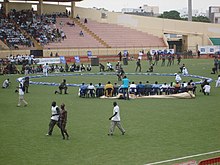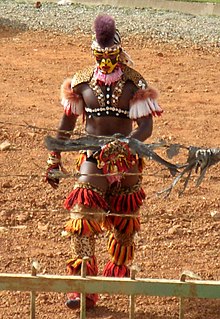Senegalese wrestling
From Wikipedia, the free encyclopedia
Senegalese wrestling (Njom in Serer, fr. Lutte sénégalaise, Laamb in Wolof) is a type of Folk wrestling traditional performed by the Serer people and now a national sport in Senegal and parts of The Gambia, and is part of a larger West African form of traditional wrestling (fr. Lutte Traditionnelle).[1] The Senegalese form traditionally allows blows with the hands (frappe),
the only of the West African traditions to do so. As a larger
confederation and championship around Lutte Traditionnelle has developed
since the 1990s, Senegalese fighters now practice both forms, called
officially Lutte Traditionnelle sans frappe (for the international version) and Lutte Traditionnelle avec frappe for the striking version.[2]
Contents |
History
| Part of a series on |
| Serers and Serer religion |
|---|
  |
Transcending ethnic groups, the sport enjoys the status of national sport.[13] Traditionally, young men also used to fight as a distraction, to court wives, prove their manliness, and bring honor to their villages. Usually each wrestler (called mbër) performed a particular dance (called a bàkk) before the start of the combat.
Today it is very popular in the country as an indication of male athletic strength and ability.[14] Presently, wrestling is arranged by business-promoters who offer prizes for the winners.
Goal

Champion wrestler Yékini (Yakhya Diop).
Training
Senegalese wrestlers train extremely hard and may perform press ups and various difficult physical exercises throughout the day to build up their strength. However whilst they believe strength is important they also believe that there is an element of luck in the winner, and may perform black magic rituals before a match to increase their chances. Common to Senegalese wrestlers is rubbing a foot on a stone or rubbing themselves with lotions or oils to increase good luck.Media
In April 2008 a BBC documentary entitled Last Man Standing covered the lives of a group of British and American hopefuls at a boot camp in Senegal who took on Senegalese opponents. Laamb was featured in the 2005 film L'Appel des arènes (English title Wrestling Grounds).Etymology
Laamb is the Wolof word for wrestling which is borrowed from Serer Fara-Lamb Siin.The Serer word for wrestling is njom which derives from the Serer word jom (heart or honour).Champions
Since the 1950s, Senegalese Wrestling, like its counterparts in other areas of West Africa, has become a major spectator sport and cultural event. The champions of traditional wrestling events are celebrities in Senegal, with fighters such as Yékini (Yakhya Diop), Tyson (Mohamed Ndao), and Bombardier (Serigne Ousmane Dia) the best known.SENEGAL-SPAIN-WRESTLING-ESPINO
Spanish wrestler Juan Francisco Espino (C) gestures at supporters as he enters the arena for a match against Senegalese wrestler Keur Diene, at the Iba Mar Diop Stadium in Dakar on June 30, 2012. Espino, who originally discovered his passion for the sport at home with his father and family on the Canary Islands, went on to learn about a variety of forms of wrestling, in Brazil and South Korea, before developing a specific interest in Senegalese wrestling. Espino is the first foreigner to brave his way into Senegalese wrestling arenas, where fans are very excited about the sport and Espino earned the nickname 'White Lion' after winning several matches. AFP Photo


No hay comentarios:
Publicar un comentario